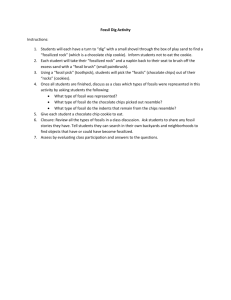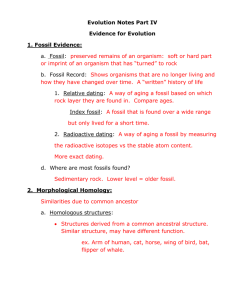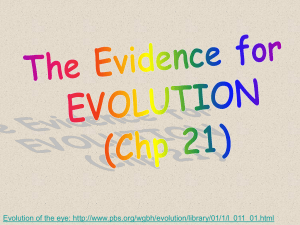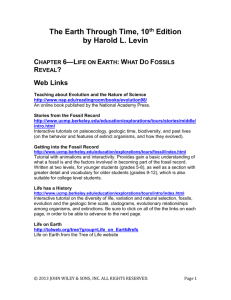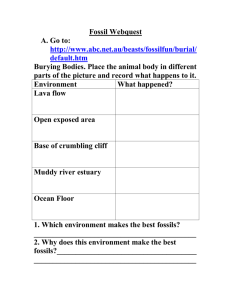File transitional fossils outline & resources1
advertisement
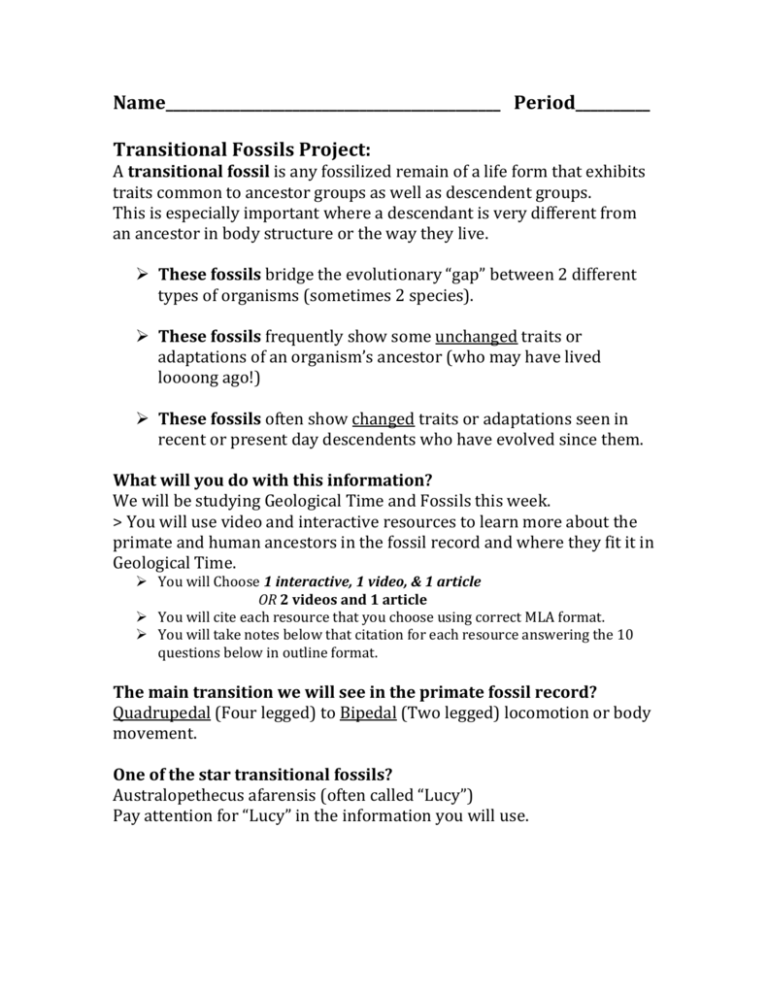
Name_____________________________________________ Period__________ Transitional Fossils Project: A transitional fossil is any fossilized remain of a life form that exhibits traits common to ancestor groups as well as descendent groups. This is especially important where a descendant is very different from an ancestor in body structure or the way they live. These fossils bridge the evolutionary “gap” between 2 different types of organisms (sometimes 2 species). These fossils frequently show some unchanged traits or adaptations of an organism’s ancestor (who may have lived loooong ago!) These fossils often show changed traits or adaptations seen in recent or present day descendents who have evolved since them. What will you do with this information? We will be studying Geological Time and Fossils this week. > You will use video and interactive resources to learn more about the primate and human ancestors in the fossil record and where they fit it in Geological Time. You will Choose 1 interactive, 1 video, & 1 article OR 2 videos and 1 article You will cite each resource that you choose using correct MLA format. You will take notes below that citation for each resource answering the 10 questions below in outline format. The main transition we will see in the primate fossil record? Quadrupedal (Four legged) to Bipedal (Two legged) locomotion or body movement. One of the star transitional fossils? Australopethecus afarensis (often called “Lucy”) Pay attention for “Lucy” in the information you will use. *Use Our Class Website “Resources” to Access the PBS Learning Media Website Thursday HW “Evolving Ideas: Did Humans Evolve?” (Video) Weekend Work “Who’s Who in Human Evolution” (Interactive) Monday Classwork Transitional Fossil Science Starter “Laetoli Footprints” (V) “Laetoli Trackways Diagram” Monday HW “Finding Lucy”(V) & From above 3 videos and 1 interactive please do 1-2 of your resource outlines. Due Tuesday 1/27 In case of a snow day, you may email these to aworley@rhinebeckcsd.org till 8pm. Tuesday Classwork (Available online if school is cancelled for snow) Class reading of “Transforming Leap from Four Legs to Two” (Article) Group discussion (questions available online if school is cancelled for snow) Tuesday HW “Where and When did Humans Evolve?” “Fossil Evidence of Bipedalism” (V) Wednesday Classwork (Available online if school is closed) Wed science starter Look at “Origins of Humankind” (I) Group work on “Did Humans Evolve” (V) & above (I) Wednesday HW “Becoming a Fossil” (V) Look at “Fossil Evidence” (I) Thursday Classwork “Riddle of the Bones” (I) group work Thursday HW Complete the final 1 or 2 resource outlines from the above Videos, Article, Interactives. Due Friday 1/30 no matter what snow days we have had during the week! If needed, you may email to aworley@rhinebeckcsd.org Citation for resource # (1, 2, or 3) belongs here o Which of the four types of evidence for evolution does this resource use? o Name one scientist presenting this resource for video resources. o Name the Transitional Fossil/ Fossils this resource looks at (1-5). o When did that fossil live, or when was it made by a living organism in (mya) millions of years ago? o What are the adaptations or structures visible in the fossil record of this fossil? Please use the bullets below to categorize and list the adaptations. If specific structures (adaptations) in this fossil have remained unchanged from the common ancestor of apes and humans, please describe 2-3. 1 2 3 If specific structures (adaptations) of this fossil have changed from the common ancestor of apes and humans, please describe 2-3? 1 2 3 o Does this fossil show further information that you did not list above? o How does this resource say that quadrupedal bodies were well suited to the environment in which they lived (if at all)? o Describe 2-3 advantages (if any) this resource explains for being bipedal. 1 3 o Describe changes in environment (if any) this resource states that bipedal primates may have been well adapted to survive. o Conclusion: How does this fossil or fossil evidence support Darwin’s idea of common ancestory?



